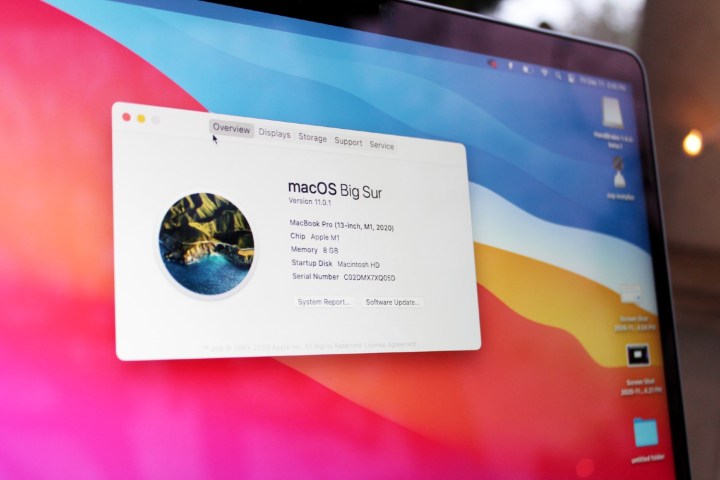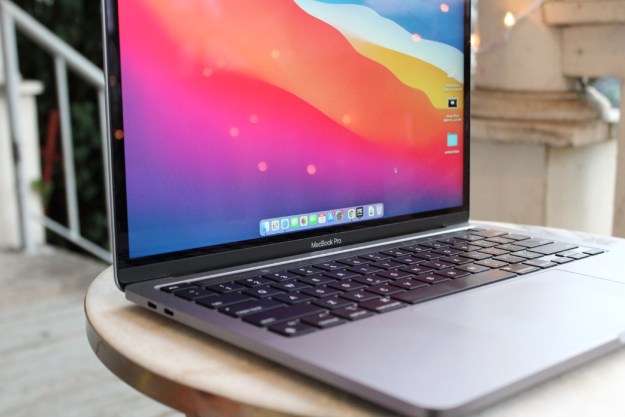
- M1 is insanely fast
- Beautiful display, as always
- Fantastic battery life
- Speakers sound brilliant
- Top-notch keyboard and trackpad
- Only two Thunderbolt ports
- Touch Bar is still frustrating
Only Apple would dare sell a laptop in 2020 based solely on its processor. Its primary audience isn’t exactly chip-heads who make purchasing decisions based on core counts and performance per watt.
And yet, Apple has managed to drum up a huge amount of hype surrounding its new M1 chip and the familiar old Macs that run on it.
The design of the new MacBook Pro 13-inch itself hasn’t changed at all with the M1 version. It’s identical to the Intel-based model that came out earlier this year. But the M1 processor promises something that a new paint job never could. It’s poised to transform the MacBook Pro 13-inch from just another laptop to something new. Something distinctly Apple. And yes, finally, something better.
Performance
The MacBook Pro 13-inch is among the first of a new generation of Macs that also includes the new MacBook Air and Mac mini. They all run on the same M1 chip, though performance will vary between the three systems. The Pro’s performance is supposed to sit in between the Air and mini in performance. At least, that’s the idea.
The MacBook Pro 13-inch was already the most powerful laptop in its size. The customized 25-watt Intel chip Apple uses already has more juice in it than the typical 13-inch laptop. You can still buy this Intel model, but it starts at $1,799. Don’t bother with it. It features two extra Thunderbolt ports, but Apple’s own eight-core 5nm ARM processor blows Intel’s out of the water in all the ways that matter.
The MacBook Pro 13-inch is still really fast. The scores it posted in benchmarks made me do a double-take, whether that’s Geekbench 5 or Cinebench R23. In single-core performance, it’s neck and neck with the fastest Intel and AMD chips, such as the Core i7-1165G7 in the Dell XPS 13. Multi-core performance is where the M1 truly shines. With eight cores, it easily outpaces the quad-core laptops it’s priced against. The only laptops with faster multi-core scores in Geekbench 5 are large, 45-watt laptops like the Dell XPS 17 or Acer ConceptD 7 Ezel.
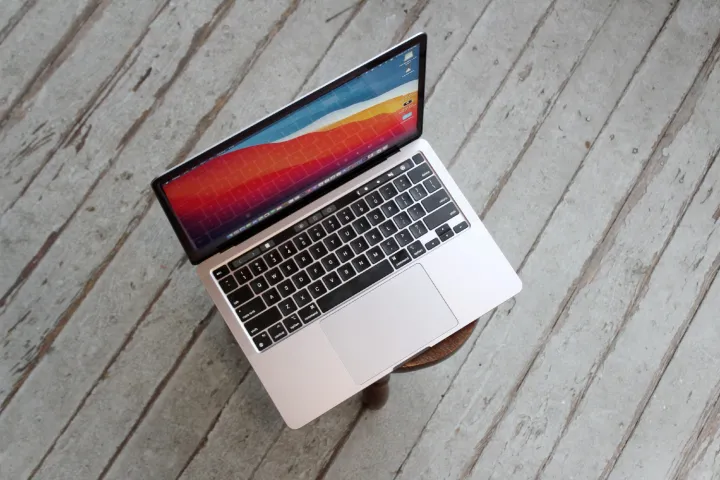
That translated to similar results in Cinebench R23 as well. Single-core scores are at the top of the pack, and multi-core scores are far ahead of the competition. But remember: The MacBook Air features this same M1 chip. Despite not having a fan in a slightly thinner chassis, it’s only 11% behind the MacBook Pro in this benchmark. There’s only a $300 price difference between the Air and the Pro, but performance difference is smaller than it used to be.
Of course, these benchmarks have already been optimized for the M1. That’s not true of the vast majority of the available apps out there. But that doesn’t mean you’ll necessarily notice those that are unoptimized lagging behind, especially if your basic workflow consists of basic web browsing and word processing.
The MacBook Pro isn’t technically fanless, but I’ve yet to hear the fans spin up.
What you will notice, though, is how this laptop is cooled. You’ll notice it when you boot up a Zoom call and not have to shout over the fan noise. Or maybe when you have a couple of 4K monitors plugged in and are multitasking without it even getting warm. Unlike the MacBook Air, the MacBook Pro isn’t technically fanless — it has a fan in there that can spin up when needed. But I never heard it spin up once. Not once. That’s a far cry from the MacBooks of yore.
Good luck running a game like Fortnite on an Intel MacBook. Not only does it run poorly due to the lame integrated graphics, it also turns your MacBook into a portable space heater. Your palms are sweaty, the keyboard is hot to the touch, and the fans are spinning up like they’re trying to prevent a nuclear meltdown.
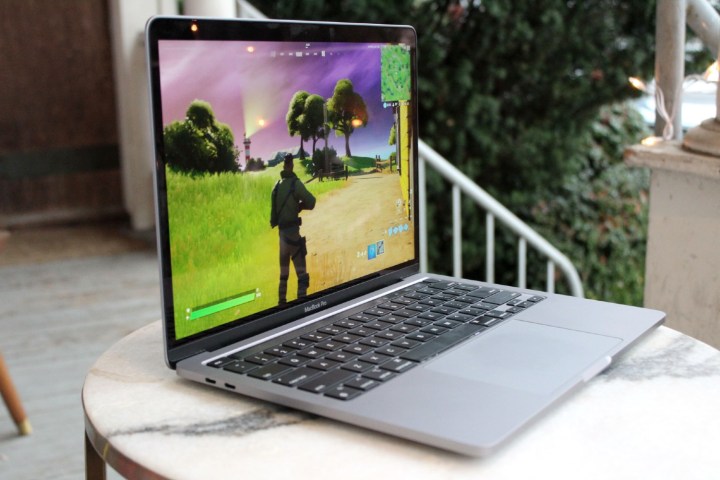
On the MacBook Pro 13-inch M1, the experience couldn’t be more different. First off, it hits 60 frames per second (fps) at medium settings with no problem. More importantly, it does so without even slightly warming up. Even $2,000 gaming laptops can’t pull that off.
There are limitations to gaming, of course. These are integrated graphics, after all, but they are a major leap ahead of what either AMD or Intel is able to offer. Like with the iPad or the iPhone, the M1 integrated graphics finally transform the MacBook Pro 13-inch into a decent gaming machine.
Take all that with a grain of salt, though. The performance you can expect from the M1 MacBook Pro depends highly on what applications you need. So, let’s address the big elephant in the room: App compatibility.
App support
As previously stated, the M1 chip marks a dramatic departure from Intel and traditional x86 systems. Such a drastic turn makes app compatibility a major hurdle to jump. Apple hasn’t shied away from making big claims about its solutions, but you’re right to be skeptical. Look no further than Microsoft’s app disaster with the original Surface Pro X for an example of how poor this type of transition could be handled.

It’s no surprise that the MacBook Pro is insanely fast at Apple’s own proprietary apps that have been compiled natively for this new architecture. If you’re running Safari, GarageBand, or even Final Cut Pro, you’ll find that the MacBook Pro delivers professional-level performance. Want to do some music production or video editing on the side? No problem. The MacBook Pro 13-inch has you covered, especially if you stick with Apple’s software. From what we’ve seen, even the MacBook Air can handle these workflows with ease.
But if you’re a creative professional or hobbyist, you probably already have your chosen applications you work with — and they might not all be from Apple. Because the M1 is an ARM-based processor, it can’t run software that was written for x86, which is most of the applications you can download off the web. There are a handful of key developers that have already optimized their apps for the M1. Microsoft, for example, has already brought over its Office suite. The same goes for Google Chrome. For many people, that covers the majority of what they use on a daily basis.
There are some holes, though. Adobe’s creative suite is the most important example. Native versions of Premiere Pro, Photoshop, and Lightroom won’t be ready until sometime in 2021. They’re coming, but for now, the M1 has to run an emulated version. But don’t worry. Apple has managed to make these apps work much better than you might think. Apple’s solution is an app translation process called Rosetta 2 — and it’s mind-blowing how well it works.
Developers are quickly updating software to be compliant with the M1.
The MacBook Pro 13-inch can export a video project in Premiere just as fast as your average x86-based 13-inch laptop, including the Intel version of the MacBook Pro. That means you can safely switch to the M1 MacBook Pro without having to worry about performance in nonnative apps.
Of course, there will always be exceptions. I tried downloading the Epic Games Launcher, for example, and oof. It’s extremely sluggish. Once you load up a game, it’s great — but the launcher and storefront itself lags. Old software tied to specific accessories or hardware might have similar issues.
It was also dreadfully slow at encoding video in Handbrake. It took five minutes and 28 seconds to complete a 4K video encode to H.265. That is, until Handbrake released a new version (1.4), which was optimized for the M1. Now? That encode time is down to just two minutes and 38 seconds. That’s 15% faster than the 10th-gen Intel Core i5 MacBook Pro 13-inch in completing the same encoding task. It goes to show just how quickly developers are updating software to be compliant.
Battery life
Of course, the benefits of the M1 processor extend far beyond just performance. The laptop starts up lightning fast when you open the lid — and even connects to external displays fast. The greatest quality of life enhancement you’ll experience with it, though, is battery life. The MacBook Pro 13-inch has never been a battery life champion, just barely squeaking by enough to be considered adequate. But not with the M1.
This MacBook Pro 13-inch has some of the best battery life I’ve ever tested on a laptop, despite having just a 58-watt battery. In light web browsing, the MacBook Pro 13-inch lasted well over 16 hours on a single charge. That’s a heck of a lot of screen-on time. It beats many of the best Windows laptops, such as the Dell XPS 13 or the HP Spectre x360. On a lighter load like local video loop, the MacBook Pro can even last over 21 hours. Whew.
Nearly doubling battery life without changing battery size is a huge accomplishment.
The best part? Just because the battery low notification comes up, it doesn’t mean you’re doomed. The MacBook Pro 13-inch can last another hour or so, especially if you turn down the brightness a bit.
Processors with ARM designs are known for extreme efficiency, so I wasn’t too surprised to see the MacBook Pro excel in this area. Even so, nearly doubling the battery life of previous models without changing the size of the battery is a huge accomplishment.
Design
A laptop is a lot more than just a processor, of course. The display, keyboard, trackpad, speakers, port selection, portability, and battery life are all equally important. Not much has changed in that regard, but it’s still where the MacBook Pro excels. For the most part.
The chassis is 0.61 inches thick and weighs exactly three pounds. In 2016, when this design was first used, it was breaking new ground. These days, it’s par for the course. You’ll find thinner, lighter, and every bit as sturdy laptops out there, such as the Dell XPS 13, HP Spectre x360, Lenovo ThinkPad X1 Carbon, and Microsoft Surface Laptop 3.
Still, it’s a supremely well-engineered laptop, without a hint of flex or bend — and that includes in the lid.

There’s room for improvement, though. I want nothing more than a MacBook Pro with some modern-looking bezels. Laptop designers have made huge strides in this department, but Apple has seemed content to leave things as is. To make things worse, the 720p webcam housed in that fat bezel isn’t much good anyway.
I expect all that to change in 2021 with the launch of a 14-inch MacBook Pro to replace this one. But if you’re buying a MacBook Pro today, that won’t help you much.
This particular MacBook Pro includes just two USB-C/Thunderbolt ports, both on the left side. These handle DisplayPort, charging, and data transfers up to 40Gb/s. I personally prefer to have a charging port on both sides of the laptop for convenience, such as on the Dell XPS 13.
The four Thunderbolt ports on the Intel version of the MacBook Pro are really its only advantage over the M1 version.
Display and speakers
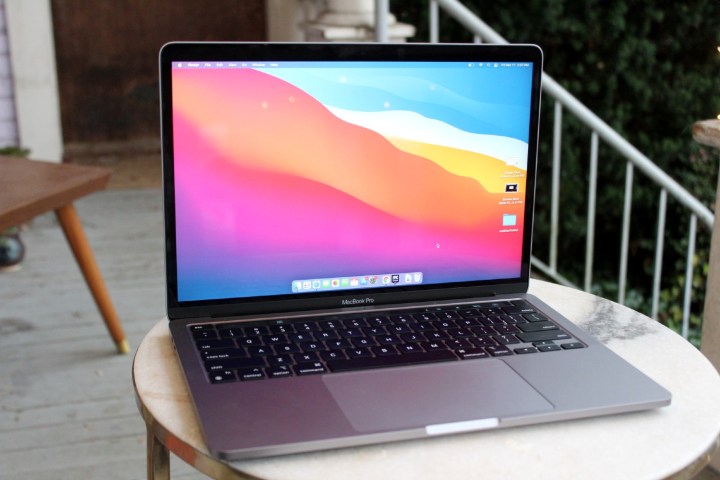
There’s never been much room for complaint with the MacBook Pro’s screen. The 2,560 x 1,600 “Retina” display is sharp, bright, and color-precise. With the abundance of 4K screens available in laptops, the MacBook Pro in comparison is missing some pixels. Not that you’ll notice, of course. Just don’t be surprised if next year Apple makes a big deal about surpassing 5K with its pixel count. It may even use mini-LED technology!
One caveat to make: I couldn’t get our colorimeter software to run. It’s a good example of a niche piece of software that just refused to run on the M1. I confirmed with Apple, however, that this was an identical panel to the previous model, which included a max brightness of 485 nits, a contrast of 1470:1, and 91% AdobeRGB color space.
The M1 chip allows Apple to do the audio processing all on its own.
The 16:10 aspect ratio has been used by Apple for many years, but it’s now finally being picked up by companies like Dell and HP. Clearly, Apple has been right all along.
The speakers are yet another area where Apple has always been in the lead. No competitors even come close. On this new model, Apple has taken it further, making some tweaks to the tuning of the speakers. The M1 chip allows Apple to do the audio processing all on its own, opening up opportunities to tinker with the stereo spread and the equalization. This was handled previously with the T2 chip, but tighter control means more opportunity for tuning.
The result is fantastic audio quality, especially when listening to music. Unlike most laptops, it’s actually a joy to listen to music on. The speakers get plenty loud without crackling or distortion, and there’s even a fair amount of bass. It’s a marvel considering how small these speakers are, but Apple’s extra engineering takes them to the next level.
Keyboard and touchpad

I won’t spend too much time complimenting Apple on the fix-up of its keyboard. Gone are the days of unreliable and uncomfortable butterfly keyboards. Apple’s Magic Keyboard, which uses a more conventional scissor switch, debuted in the MacBook Pro 13-inch from earlier this year. It’s still here, and it’s still fantastic.
The same goes for the trackpad, which is extra large and responsive. The Force Touch technology means there’s no physical mechanism underneath the glass — just a highly sensitive series of motors that replicate the feeling of motion.
Meanwhile, I’ll continue to bemoan the missed opportunity that is the Touch Bar. I almost never use it. And when I do, such as to adjust volume or screen brightness, it’s annoying. My only hope is that Apple now has improved tools for better implementation in the future, but for now, it doesn’t add up to much of a feature.
Our take
The $1,299 MacBook Pro 13-inch M1 is a fresh start for the Mac. The physical design will catch up eventually, but for now, what we have is the beginning of a season for the Mac where it will be hard to compete with.
Are there any alternatives?
The closest competitor is the Dell XPS 13. I prefer the slim-bezel design of Dell’s laptop, as well as the option for a 4K model. The MacBook Pro 13-inch M1 is a more powerful laptop now, though, and beats it in battery life.
If you don’t need the extra performance afforded by the Pro, the MacBook Air should be considered. It uses a slightly lower-powered version of the M1, but only starts at $999 (or $899 with student discount).
How long will it last?
Being built on Apple’s new system architecture, the MacBook Pro 13-inch M1 is a safe purchase. It’ll be supported for many years. That being said, a major redesign of the MacBook Pro is said to be launching in 2021, though it may be a while until we hear more.
All of Apple’s MacBooks come with a standard one-year limited warranty. Of course, you can enjoy Apple’s excellent AppleCare+ service for up to three years, though it’ll cost you extra.
Should you buy it?
Absolutely. More than any MacBook Pro in the past few years, Apple has finally made one that has an undeniable advantage over its rivals.
Editors' Recommendations
- The XPS 16 is fighting an uphill battle against the MacBook Pro
- MacBook Pro 16 vs. MacBook Pro 14: The important differences
- Best laptop deals: Save on the Dell XPS 14, MacBook Pro 16 and more
- Best Apple deals: Save on AirPods, Apple Watch, iPad, MacBook
- The MacBook Air 15 vs. MacBook Pro 14: the easy way to decide

